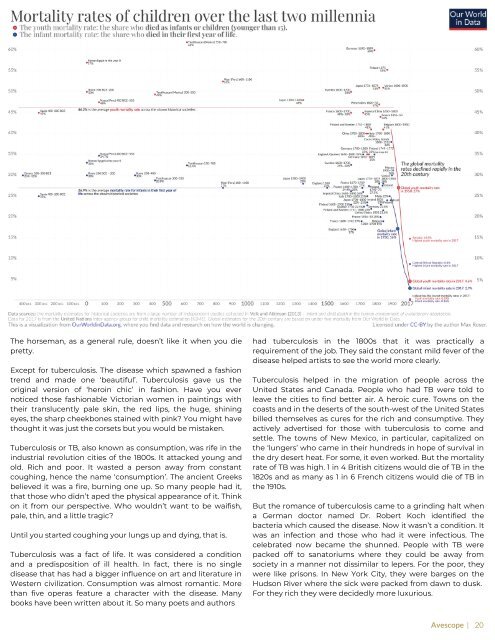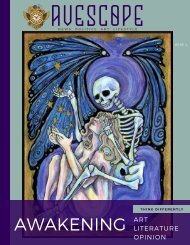Avescope Memento Mori
Avescope Memento Mori. Remember Death. An amazing new magazine about death and remembrance. Art. Photography. History. Fiction. Culture. Poetry. Avescope Memento Mori has it all. This issue is so amazing, it almost makes julienne fries. Thanks to all our contributors: Catherine Clark, Joanna Hatton, Tamsin McKenna-Williams, Catherine Jackson, Blackbird's Photography, Auguste von Osterode, David Simon, Anike Kirsten, Kimm Fernandez, Neva Lee, Tiffany Tong, Matthew Sheetz, Christopher Antim, Karen Lee, LD Towers
Avescope Memento Mori. Remember Death. An amazing new magazine about death and remembrance. Art. Photography. History. Fiction. Culture. Poetry. Avescope Memento Mori has it all. This issue is so amazing, it almost makes julienne fries. Thanks to all our contributors:
Catherine Clark,
Joanna Hatton,
Tamsin McKenna-Williams,
Catherine Jackson,
Blackbird's Photography,
Auguste von Osterode,
David Simon,
Anike Kirsten,
Kimm Fernandez,
Neva Lee,
Tiffany Tong,
Matthew Sheetz,
Christopher Antim,
Karen Lee, LD Towers
You also want an ePaper? Increase the reach of your titles
YUMPU automatically turns print PDFs into web optimized ePapers that Google loves.
The horseman, as a general rule, doesn’t like it when you die<br />
pretty.<br />
Except for tuberculosis. The disease which spawned a fashion<br />
trend and made one ‘beautiful’. Tuberculosis gave us the<br />
original version of ‘heroin chic’ in fashion. Have you ever<br />
noticed those fashionable Victorian women in paintings with<br />
their translucently pale skin, the red lips, the huge, shining<br />
eyes, the sharp cheekbones stained with pink? You might have<br />
thought it was just the corsets but you would be mistaken.<br />
Tuberculosis or TB, also known as consumption, was rife in the<br />
industrial revolution cities of the 1800s. It attacked young and<br />
old. Rich and poor. It wasted a person away from constant<br />
coughing, hence the name ‘consumption’. The ancient Greeks<br />
believed it was a fire, burning one up. So many people had it,<br />
that those who didn’t aped the physical appearance of it. Think<br />
on it from our perspective. Who wouldn’t want to be waifish,<br />
pale, thin, and a little tragic?<br />
Until you started coughing your lungs up and dying, that is.<br />
Tuberculosis was a fact of life. It was considered a condition<br />
and a predisposition of ill health. In fact, there is no single<br />
disease that has had a bigger influence on art and literature in<br />
Western civilization. Consumption was almost romantic. More<br />
than five operas feature a character with the disease. Many<br />
books have been written about it. So many poets and authors<br />
had tuberculosis in the 1800s that it was practically a<br />
requirement of the job. They said the constant mild fever of the<br />
disease helped artists to see the world more clearly.<br />
Tuberculosis helped in the migration of people across the<br />
United States and Canada. People who had TB were told to<br />
leave the cities to find better air. A heroic cure. Towns on the<br />
coasts and in the deserts of the south-west of the United States<br />
billed themselves as cures for the rich and consumptive. They<br />
actively advertised for those with tuberculosis to come and<br />
settle. The towns of New Mexico, in particular, capitalized on<br />
the ‘lungers’ who came in their hundreds in hope of survival in<br />
the dry desert heat. For some, it even worked. But the mortality<br />
rate of TB was high. 1 in 4 British citizens would die of TB in the<br />
1820s and as many as 1 in 6 French citizens would die of TB in<br />
the 1910s.<br />
But the romance of tuberculosis came to a grinding halt when<br />
a German doctor named Dr. Robert Koch identified the<br />
bacteria which caused the disease. Now it wasn’t a condition. It<br />
was an infection and those who had it were infectious. The<br />
celebrated now became the shunned. People with TB were<br />
packed off to sanatoriums where they could be away from<br />
society in a manner not dissimilar to lepers. For the poor, they<br />
were like prisons. In New York City, they were barges on the<br />
Hudson River where the sick were packed from dawn to dusk.<br />
For they rich they were decidedly more luxurious.<br />
<strong>Avescope</strong> | 20





